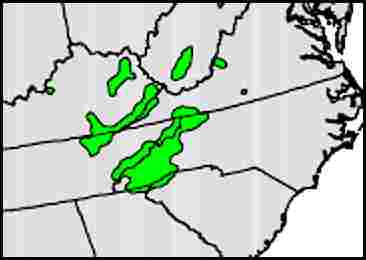Cinnamon Clethra
(Clethra acuminata)
Cinnamon Clethra is a small deciduous tree native to the southern Appalachian region. Its common name comes from the beautiful cinnamon color of the inner bark, which is naturally revealed as the outer layers peel away. Actually the color varies somewhat, from pinkish gold to ochre red, and variations on the same plant can create a mottled pattern. The effect is especially apparent in winter.
The tree is sometimes called Cinnamonbark Clethra. Another common name, Mountain Pepperbush, comes from its spicy-tasting seeds, which early settlers used as a substitute for black pepper.
The flowers, long spires of small white bells, appear in early summer when few other plants are in bloom. The individual blossoms open sequentially from the base to the tip of the spire and are a good nectar source for butterflies. The rich-green leaves are oval-shaped with a pointed tip and turn gold or yellow before dropping in autumn. The tiny seeds are most likely to germinate when they fall on moss-covered soil.
This plant sometimes tries to grow as a shrub, but can usually be pruned to a tree form. This is generally preferred, since it accentuates the effect of the beautiful bark. Even in tree form the plant seldom grows more than 20 feet tall, and is therefore an excellent choice for small properties. Because it is an understory species, it can survive in fairly heavy shade, but it will bloom much better if it receives at least a few hours of direct sunlight.
Clethra acuminata is found in small scattered populations from southern Pennsylvania to northern Alabama. The national co-champions, both about 30 feet tall, grow in the Great Smoky Mountains National Park. Wild plants are usually found in moist areas, but cultivated specimens can adapt to drier sites.
This is a very attractive landscape plant.
Other Information
Scientific Name: Clethra acuminata
Common Names: Cinnamon Clethra, Cinnamonbark Clethra, Mountain Pepperbush
Plant Type: Small deciduous tree; sometimes shrublike
Height: Usually 12-20 feet, but sometimes taller.
Cultivation Zones: 5 - 8
Native Habitat: Mountainous areas in understory or openings near streams.
Native Range: Found mainly in the southern mountains. See distribution map below.
Distribution Map

Range Map Source: U.S. Forest Service. (See General Note C)
Conservation Status: NatureServe lists Clethra acuminata as Critically Imperiled in Alabama and Pennsylvania. The species is officially classified as Endangered by Pennsylvania.
Cultivation: Give this plant moist humus-rich acid soil with good drainage, and water during droughts, especially when young. Fertilize lightly or not at all. It can tolerate shade, but will grow faster and bloom better in a sunny location. The tiny seeds should be sown under glass in spring. Go to Cultivation and Seeds for more information.
Related Species: Summersweet (Clethra alnifolia) is a similar but smaller and shrubbier eastern native. Other clethras are found in Asia.
Plant Sources: Possible suppliers of Clethra acuminata include Shooting Star Nursery, Overhill Gardens, Forest Farm, Elk Mountain Nursery, Lazy S's Farm, Meadowbrook Nurseries, and GroWild. For links to these suppliers, go to Sources of Plants.
|

